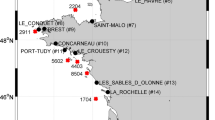Abstract
The ship-induced hydrodynamics in a canal result in different mechanism of the cross-sectional evolution. However, the ship-induced hydrodynamic factors are not induced in existing studies of cross-sectional stability of a canal. In this paper, the minimum rate of energy dissipation equations for a canal are derived based on the theory of thermodynamics, introducing the ship wave factors, and variational equation is adopted to establish the stable cross-sectional shape equations. Then, the measured results in Changzhou segment of the Grand Canal are used to evaluate the performance of the derived equations by comparing with other typical equations without considering ship wave factors. The results show that the derived equations give better prediction of the cross-sectional area, mean water depth, maximum water depth and the bottom width of the stable cross-section with the relative error less than 20%. At last, an application of the derived equations is given for Yan River to predict the stable cross-sectional shape.
Similar content being viewed by others
References
Afzalimehr H, Abdolhosseini M, Singh VP (2010) Hydraulic geometry relations for stable channel design. Journal of Hydrologic Engineering 15(10):859–864, DOI: 10.1061/(ASCE)HE.1943-5584.0000260
Bellafiore D, Zaggia L, Broglia R, Ferrarin C, Benetazzo A (2018) Modeling ship-induced waves in shallow water systems: The Venice experiment. Ocean Engineering 155(2018):227–239, DOI: 10.1016/j.oceaneng.2018.02.039
Chang M, Xu GB (2013) Numerical simulation of fluid motion in flume based on theory of minimum rate of energy dissipation. Journal of Sediment Research 2:67–71, DOI: 10.16239/j.cnki.0468-155x.2013.02.005 (in Chinese)
Chen YM, Hu FQ (2016) Study on the hydraulic geometry of the canal section under the action of ship-generated waves and currents. Proceedings of the international offshore and polar engineering conference, June 26–July 1, Rhodes, Greece
Diplas P, Vigilar G (1992) Hydraulic geometry of threshold channels. Journal of Hydraulic Engineering 118(4):597–614, DOI: 10.1061/(ASCE)0733-9429(1992)118:4(597)
Erm A, Alari V, Listak M (2009) Monitoring wave-induced sediment resuspension. Estonian Journal of Engineering 15(3):196–211, DOI: 10.3176/eng.2009.3.04
Fleit G, Baranya S, Rüther N, Bihs H, Kramer T, Jozsa J (2016) Investigation of the effects of ship induced waves on the littoral zone with field measurements and CFD modelling. Water 8%(7):300, DOI: 10.3390/w8070300
Gao SZ, Zhao LN, You ZJ, Zheng CM (2017) Stability criterion for riverbed based on minimum rate of energy dissipation. Journal of Jiangsu University 38(6):737–744, DOI: 10.3969/j.issn.1671-7775.2017.06.020 (in Chinese)
Gelinas M, Bokuniewicz H, Rapaglia J, Lwiza KMM (2013) Sediment resuspension by ship wakes in the Venice Lagoon. Journal of Coastal Research 29(1):8–17
Glover RE, Florey QL (1951) Stable channel profiles. Hydraulics Laboratory Report Hyd-325, US Bureau of Reclamation, Washington, DC, USA
Göransson G, Larso M, Althage J (2014) Ship-generated waves and induced turbidity in the Göta Älv River in Sweden. Journal of Waterway Port Coastal & Ocean Engineering 140(3):1–11, DOI: 10.1061/(ASCE)WW.1943-5460.0000224
Houser C (2011) Sediment resuspension by vessel-generated waves along the Savannah River, Georgia. Journal of Waterway Port Coastal & Ocean Engineering 137(5):246–257, DOI: 10.1061/(ASCE)WW.1943-5460.0000088
Huang CA, Gong MF, Chen ZC, Qian WK (2005) Stable channel shape based on the principle of minimum stream power. Journal of Hydrodynamics 20(2):189–195, DOI: 10.16076/j.cnki.cjhd.2005.02.009 (in Chinese)
Huang CA, Zhou JR, Zhao XD (2011) Theoretical study of exponent in basic hydraulic geometry relation. Journal of Sediment Research 18%(6):55–58, DOI: 10.16239/j.cnki.0468-155x.2011.06.011 (in Chinese)
Ikeda S, Izumi N (1991) Stable channel cross sections of straight sand rivers. Water Resources Research 27(9):2429–2438, DOI: 10.1029/91WR01220
Julien PY, Wargadalam J (1995) Alluvial channel geometry: Theory and applications. Journal of Hydraulic Engineering 121(4):312–325, DOI: 10.1061/(ASCE)0733-9429(1995)121:4(312)
Mao LL, Chen YM (2018) Entropy-based approach of hydraulic geometryof navigable canals. Journal of Hydrologic Engineering 23(11):1–11, DOI: 10.1061/(ASCE)HE.1943-5584.0001709
Mwiya RM (2013) Parabolic channel design. International Journal of Scientific & Engineering Research 4(4):804–809
Parker G (1979) Hydraulic geometry of active gravel rivers. Journal of the Hydraulics Division 105(9):1185–1201, DOI: 10.1080/09715010.2001.10514698
Sorensen RM (1997) Prediction of vessel-generated waves with referenceto vessels common to the upper Mississippi River System. NV Report 4, U.S. Army Engineer Waterways Experiment Station, Vicksburg, MS, USA.
Torsvik T (2009) Modelling of ship waves from high-speed vessels. In: Applied wave mathematics. Springer, Berlin, Germany, 229–263
Xu GB, Lian JJ (2004) Theories of the minimum rate of energy dissipation and the minimum entropy production of flow (I). Journal of Hydraulic Engineering 34(5):35–40, DOI: 10.13243/j.cnki.slxb.2003.05.006 (in Chinese)
Yan YY, Ge L, Gao J (2003) Application of the minimum energy dissipationrate theory in the braided river. Journal of Hydrodynamics 18(6):692–697, DOI: 10.3969/j.issn.1000-4874.2003.06.004 (in Chinese)
Yang CT (1979) Theory of minimum rate of energy dissipation. Journal of the Hydraulics Division 105(7):769–784
Yang CT, Molinas A (1982) Sediment transport and unit stream power function. Journal of the Hydraulics Division 108(6):774–793
Acknowledgements
This research was supported by the National Natural Science Foundation of China (No. 51479035) and the Scientific Research Foundation of Graduate School of Southeast University (No. YBPY1883).
Author information
Authors and Affiliations
Corresponding author
Rights and permissions
About this article
Cite this article
Chen, Y., Mao, L. & Xia, F. Cross-Sectional Stability of a Canal under the Action of Ship Waves Based on Minimum Energy Hypothesis. KSCE J Civ Eng 24, 1731–1739 (2020). https://doi.org/10.1007/s12205-020-1675-9
Received:
Revised:
Accepted:
Published:
Issue Date:
DOI: https://doi.org/10.1007/s12205-020-1675-9




